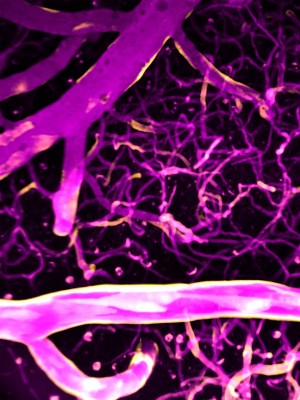July 21, 2021 | Vanessa McMains

Unlike the rest of the body, there is not enough real estate in the brain for stored energy. Instead, the brain relies on the hundreds of miles of blood vessels within it to supply fresh energy via the blood. Yet, how the brain expresses a need for more energy during increased activity and then directs its blood supply to specific hot spots was, until now, poorly understood.
Now, University of Maryland School of Medicine and University of Vermont researchers have shown how the brain communicates to blood vessels when in need of energy, and how these blood vessels respond by relaxing or constricting to direct blood flow to specific brain regions.
In their new paper, published on July 21 in Science Advances, the researchers say that understanding how the brain directs energy to itself in intricate detail can help determine what goes wrong in conditions like Alzheimer’s disease and dementia, where faulty blood flow is a predictor for cognitive impairment. If the brain does not get blood to where it needs it when it needs it, the neurons become stressed, and over time they deteriorate, ultimately leading to cognitive decline and memory problems.
Large arteries feed medium-sized vessels known as arterioles that then feed even tinier capillaries—so small that only a single blood cell can pass through at once. In a 2017 Nature Neuroscience paper, the researchers showed that electrical pulses coursing through the capillaries direct blood flow from the medium-sized arterioles supplying large regions of the brain. For this latest paper, the team wanted to study the fine-tuning of blood as it flows through the capillaries to precisely regulate energy supply to tiny regions in the brain.
“There seem to be two mechanisms working in tandem to ensure that energy in the form of blood makes it to specific regions of the brain: one broad and the other precise,” says Thomas Longden, PhD, Assistant Professor of Physiology at University of Maryland School of Medicine. “The first electrical mechanism is like a sledgehammer approach to get more blood to the general vicinity of the increased brain activity by controlling the medium-sized arterioles, and then capillary calcium signals ensure exquisite fine-tuning to make sure the blood gets to exactly the right place at the right time through the tiny capillaries.”
Dr. Longden and his collaborators used a protein which emits green light when calcium increases in the cell. Due to the efforts of Michael Kotlikoff’s team at Cornell University, they were able to turn this tool on in the cells lining the blood vessels of mice. Researchers then made a small opening in the skull forming a window that allowed researchers to view the brains of these mice to investigate calcium’s role in controlling blood flow in the brain’s capillaries. When the cells lining the blood vessels received an influx of calcium, they glowed green. Researchers detected 5,000 calcium signals per second in the capillaries in the tiny section of brain visible through the window, which they say amounts to about 1,000,000 of these responses each second in the entire brain’s blood vessel system.
“Until we deployed this new technology, there was this wholly unseen world of calcium signaling in the brain hidden from view, and now we can see a ton of activity within the brains blood vessels – they are constantly firing,” says Dr. Longden.

"Capillaries were traditionally thought as simple conduits for red blood cells, and the barrier between the blood and brain," says co-senior author Mark T. Nelson, PhD, University of Vermont Distinguished Professor and Chair of Pharmacology. "Here, we revealed an unknown universe of calcium signaling in capillaries, and much like traffic lights, these calcium signals direct vital nutrients to nearby active neurons."
“The first step towards figuring out what goes wrong in diseases is to determine how the system works as it normally should,” says E. Albert Reece, MD, PhD, MBA, Executive Vice President for Medical Affairs, UM Baltimore, and the John Z. and Akiko K. Bowers Distinguished Professor, and Dean, University of Maryland School of Medicine. “Now that the researchers have a handle on how this process works, they can begin to investigate how the blood flow is disrupted in Alzheimer’s disease and dementia in order to figure out ways to fix it.”
This study was supported by the American Heart Association, the Totman Medical Research Trust, Fondation Leducq, European Union's Horizon 2020 research and innovation programme, the Henry M. Jackson Foundation for the Advancement of Military Medicine, the National Institute of Heart, Lung, and Blood (P01HL095488, R01HL121706, 7UMHL1207704, R01HL131181, R24HL120847, R01HL120323, and R35HL140027), the National Institute of General Medical Sciences (4P20GM103644/4-5, P20GM135007), the National Institute of Neurological Disorders and Stroke (R01NS110656), the National Institute on Aging (R01AG066645), National Institute of Diabetes and Digestive and Kidney Diseases (R37DK053832), the Vermont Center for Cardiovascular and Brain Health, the University of California Irvine TMF Center supported by the National Cancer Institute (P30CA062203), and the German Research foundation (DFG)-funded Research Unit.
Dr. Longden is a recent recipient of the NIH Director’s New Innovator Award from the National Institutes of Health Office of the Director (DP2OD02944801).
More information about the work ongoing in his lab can be found at www.longdenlab.org.
The authors have no financial conflicts to report.
About the University of Maryland School of Medicine
Now in its third century, the University of Maryland School of Medicine was chartered in 1807 as the first public medical school in the United States. It continues today as one of the fastest growing, top-tier biomedical research enterprises in the world -- with 46 academic departments, centers, institutes, and programs, and a faculty of more than 3,000 physicians, scientists, and allied health professionals, including members of the National Academy of Medicine and the National Academy of Sciences, and a distinguished two-time winner of the Albert E. Lasker Award in Medical Research. With an operating budget of more than $1.2 billion, the School of Medicine works closely in partnership with the University of Maryland Medical Center and Medical System to provide research-intensive, academic and clinically based care for nearly 2 million patients each year. The School of Medicine has nearly $600 million in extramural funding, with most of its academic departments highly ranked among all medical schools in the nation in research funding. As one of the seven professional schools that make up the University of Maryland, Baltimore campus, the School of Medicine has a total population of nearly 9,000 faculty and staff, including 2,500 students, trainees, residents, and fellows. The combined School of Medicine and Medical System (“University of Maryland Medicine”) has an annual budget of over $6 billion and an economic impact of nearly $20 billion on the state and local community. The School of Medicine, which ranks as the 8th highest among public medical schools in research productivity (according to the Association of American Medical Colleges profile) is an innovator in translational medicine, with 606 active patents and 52 start-up companies. In the latest U.S. News & World Report ranking of the Best Medical Schools, published in 2021, the UM School of Medicine is ranked #9 among the 92 public medical schools in the U.S., and in the top 15 percent (#27) of all 192 public and private U.S. medical schools. The School of Medicine works locally, nationally, and globally, with research and treatment facilities in 36 countries around the world. Visit medschool.umaryland.edu
Contact
Vanessa McMains
Director, Media & Public Affairs
Institute of Human Virology
University of Maryland School of Medicine
vmcmains@ihv.umaryland.edu
443-875-6099
Related stories

Wednesday, April 02, 2025
Researchers Reveal Key Brain Differences to Explain Why Ritalin Helps Improve Focus in Some More Than Others
Nearly 16 million American adults have been diagnosed with attention deficit hyperactivity disorder (ADHD), but evidence suggests that more than 30 percent of them don’t respond well to stimulant medications like Ritalin and Adderall. A new clinical trial provides a surprising explanation for why this may be the case: There are individual differences in how our brains circuits are wired, including the chemical circuits responsible for memory and concentration, according to a new study co-led by the University of Maryland School of Medicine (UMSOM) and performed at the National Institutes of Health (NIH) Clinical Center.

Tuesday, April 25, 2023
Immune System Sculpts Rat Brains During Development
Researchers have established that biological sex plays a role in determining an individual’s risk of brain disorders. For example, boys are more likely to be diagnosed with behavioral conditions like autism or attention deficit disorder, whereas women are more likely to suffer from anxiety disorders, depression, or migraines. However, experts do not fully understand how sex contributes to brain development, particularly in the context of these diseases. They think, in part, it may have something to do with the differing sizes of certain brain regions.

Friday, March 31, 2023
Traumatic Brain Injury Interferes with Immune System Cells’ Recycling Process in Brain Cells
Each year about 1.5 million people in the U.S. survive a traumatic brain injury due to a fall, car accident, or a sports injury, which can cause immediate and long-term disability.

Friday, January 06, 2023
UM School of Medicine Scientists Create First Extensive Brain Cell Data Repository
Neuroscience researchers now have access to 50 million brain cells to better understand how the brain develops and functions or changes with disease or trauma. Last month, scientists at the University of Maryland School of Medicine’s (UMSOM) Institute for Genome Sciences (IGS) unveiled a “one-stop shop” for brain cell data called the Neuroscience Multi-Omic Archive (NeMO Archive). This archive is now available to neuroscience researchers to transform their understanding of the complex workings of the brain.

Monday, November 14, 2022
Brain Area Thought to Impart Consciousness, Behaves Instead Like an Internet Router
Tucked underneath the brain’s outer, wrinkly cortex is a deeply mysterious area, known as the claustrum. This region has long been known to exchange signals with much of the cortex, which is responsible for higher reasoning and complex thought. Because of the claustrum’s extensive connections, the legendary scientist Francis Crick, PhD, of DNA-discovery fame, first postulated in 2005 that the claustrum is the seat of consciousness. In other words, the region of the brain enabling awareness of the world and ourselves.

Tuesday, October 06, 2020
UM School of Medicine Scientist Receives Prestigious NIH Director's New Innovator Award
$2.3 million Award Targeted for “High-Risk, High Reward” Research that Aims to Understand Contribution of Blood Flow to Brain Plasticity

Wednesday, September 25, 2019
Dr. Tracy Bale Elected President of the International Brain Research Organization
Tracy L. Bale, PhD, Professor of Pharmacology and Director of the Center for Epigentic Research in Child Health & Brain Development has been elected President of the International Brain Research Organization.

Monday, April 29, 2019
UMSOM’s Reading on the Brain Program Teaches Baltimore City Elementary Students About the Brain-Building Power of Reading
Acting Baltimore City Mayor Jack Young joined 4th and 5th grade students at Callaway Elementary School to help paint a mural about the brain. It was all part of Reading on the Brain, a University of Maryland School of Medicine (UMSOM) program to teach young students about the importance of reading and how reading can stimulate brain development and inspire future success. Tracy Bale, PhD, is leading the pilot program, which also emphasizes science and helps children to understand how the brain works.

Thursday, March 28, 2019
Allergic Reactions Play Role in Sexual Behavior Development in Unborn Males and Females, UMSOM Research Shows
Researchers at the University of Maryland School of Medicine and colleagues at Ohio State University have discovered that allergic reactions trigger changes in brain behavior development in unborn males and females. This latest brain development discovery will ultimately help researchers better understand how neurological conditions can differ between men and women.

Friday, March 01, 2019
UMSOM Researchers Discover Clues to Brain Differences Between Males and Females
Researchers at the University of Maryland School of Medicine have discovered a mechanism for how androgens -- male sex steroids -- sculpt brain development. The research, conducted by Margaret M. McCarthy, Ph.D., Professor of Pharmacology and Chair of the Department of Pharmacology, could ultimately help researchers understand behavioral development differences between males and females.

Thursday, December 07, 2017
University of Maryland School of Medicine Scientists Identify the First Brain Cells to Respond to Sound
Some expectant parents play classical music for their unborn babies, hoping to boost their children’s cognitive capacity. While some research supports a link between prenatal sound exposure and improved brain function, scientists had not identified any structures responsible for this link in the developing brain.
